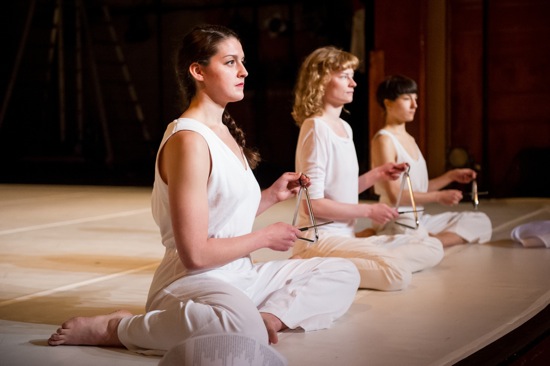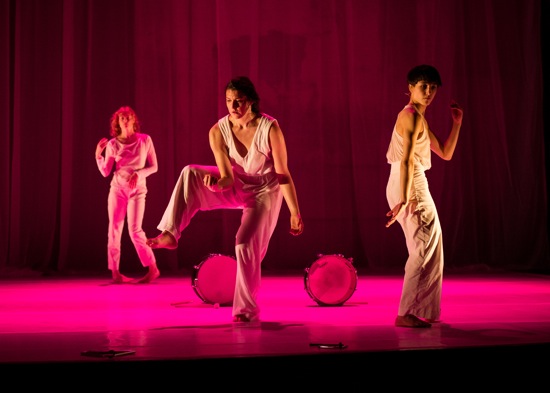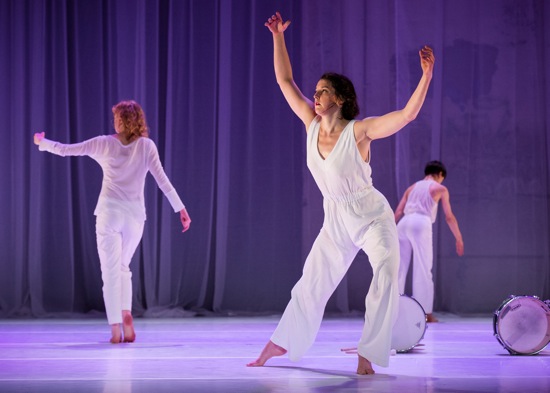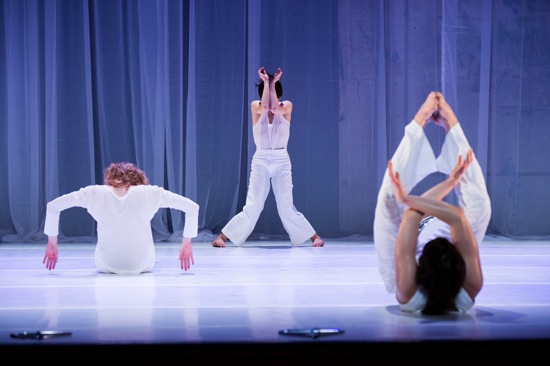Eleanor Bauer brings her work from Brussels to Manhattan.

(L to R:) Eleanor Bauer, Rebecka Stillman, and Cecilia Eliceche in Bauer’s Midday and Eternity (the time piece). Photo: Ian Douglas
Who are these three women? We potential audience members have been milling around in the Abrons Art Center lobby, chatting and wondering when the doors to the theater will open, and when they do, we enter a zone of empyrean mystery. The women in Eleanor Bauer’s Midday and Eternity (the time piece) sit in a row at the front of the stage, one of their legs folded in front of them and one behind. They’re staring toward us. At the back of the stage hangs a sheer white curtain. The performers are garbed in simple, becomingly engineered white pants and tops (by Ada Rajszys). All of them hold triangles—each slightly different in size, so that, when struck, they resonate with different pitches (I think they’re tuned in thirds). Struck singly, their sounds may increase in density or fill the silence so sparingly that the rhythm all but languishes. To stop the reverberations, the performers mute their instruments against their thighs.
The women in question differ too, and all are intriguing to watch Bauer, the choreographer, is a tall, strong woman who—it will become clear—moves with a sensuous fluidity. Cecilia Eliceche is small and nimble, especially articulate with her feet. Rebecka Stillman is not quite as tall as Bauer, and very slender, as well as more contained than the other two. However, we don’t discover this for a while. After the three have finished playing, Bardia Mohammad cools his stage lighting down, and they exchange their triangles for white Möbius strips that appear to be about 10 inches wide. From these they read diverse texts, chanting them simultaneously in low, medium, and high pitches. They stroll about, changing locations in the space, but always facing the audience. It’s impossible to catch more than scraps of what they’re saying; their stories appear to be mundane and personal.
From the outset, a drum set has stood downstage right. Now it begins to play. A ghost drummer! Of course, the percussion is on tape, but you could swear the sounds are coming from the traps we see. Chris Peck composed the music for the piece, and now it summons the women to dance. From now on, Midday and Eternity builds a structure in which dancing, reading, and producing musical sounds succeed one another.
For a good part of an hour, the piece is fascinating. Bauer, a busy, Brussels-based choreographer who graduated from NYU’s Tisch School of the Arts in 2003, creates movement that brings Trisha Brown’s combination of fluidity and precision to mind. Sometimes the three women gallop and spring and toss themselves around like young horses, but they’re also fastidious about where the curve of an arm or the swing of a leg belongs in space. I begin to notice that, although they are almost never executing the same steps at the same time, they share a common and pleasing vocabulary; they’re just rearranging the order, the directions in space, and the timing to suit them. I’m very happy watching, and have no idea why I begin to think of the dancers as grave angels at play, freed from their constraints in a Piero della Francesca nativity.
One of the sentences that emerge from the three-pitch jostling of their next bout with text is: “We’ll do it with what we have now, and it will never be the same.” That seems to be a basic principle they adhere to. Other sentences may refer to their workaday life, e.g. “The palm of your hand is sweaty.” The lights dim and brighten, become warmer or cooler. In one of the passages of dancing, the performers move slowly and/or in increments. In another, they’re tighter, stiller. Distant bells sound; perhaps they’re part of Peck’s score; perhaps they’re from a neighborhood church.

(L to R): Stillman, Bauer, and Eleceche in Bauer’s Midday and Eternity (the time piece). Photo: Ian Douglas
There’s one odd sequence. Bauer, Stillman, and Eliceche dislodge toms from drumset and sit on the floor, chanting held notes, while striking the instruments in what seems to be out-of-synch percussion. If there’s a pattern involved, it’s all but ungraspable. Taken with the chanting, it reaches pat-your-head-while-rubbing-your-stomach awkwardness and promotes uneasiness in the audience. Actually, that had been perceivable in a small way during the second chanting session. Some people begin to change their positions—the man in front of me quite often. The woman next to me starts twisting a lock of her hair. After a while, she braids a skinny pigtail, shakes it out, begins again. The man behind me uncrosses his legs, inadvertently banging the back of my seat. That I’m even aware of them tells me something.
Why is our intense, rapt focus disintegrating? Maybe the time that the piece is taking to unfold makes us restless. Perhaps it’s because the performers seem less clear about what they are doing. Or we’re wondering what, if anything, their actions may lead to. Interestingly, the women’s eyes often shift sideways, as if they’re trying to anticipate something that may be about to happen.
There are surprises though, and, finally, a sense of impending climax. For one thing, the percussion played by invisible musicians now appears also to be located upstage left. For another, one of the women touches another for the first and only time: Eliceche, on the floor, reaches out and holds Bauer’s foot. The dancers move in stiff little jolts. They rest, appear to be thinking, and listen to the rumbling and other sounds emanating from Peck’s score. Rajszys makes the overhead bank of 30 lamps turn blue. Then violet. Then makes half of them white and half pink. Then all of them white. After the lights dance, the dancers station themselves in separate spaces and form their bodies into symmetrical shapes with slo-mo gymnastic control. For a number of seconds, Bauer balances on her tailbone, opening her lifted legs wide apart.
The women’s penultimate act is to make their triangles jingle rapidly, creating an unearthly harmonic mesh. Then they leave the stage—one exiting up an aisle and into the lobby, one walking halfway up the other aisle and out a side door, the third leaving via a door to the backstage area. A low humming sound continues, while the house lights come on. We wait, uncertain. The lights go out. Can we applaud now? Yes. Back come the dancers, smiling and bowing.
Midday and Eternity (the time piece) is the third part of a trilogy. The preceding works are the 2011 sextet A Dance for the Newest Age (the triangle piece) and the 2012 Tentative Assembly (the tent piece), a dance for nine. Bauer’s program biography states that “the trilogy deals with triads such as past-present-future and science-politics-spirituality to approach the wholistic (sic?) nature of dance and choreography.” (Hmm. What doesn’t that rule out?) Midday and Eternity appeared without much publicity among the many events that blossomed during and right after the week in which presenters and producers gathered in Manhattan to window-shop and confer. Then it vanished, leaving a number of questions and enough resonant images to make me wish I could see the two dances that came before it.



Thank you for capturing so well the forms, sounds, and feeling of Bauer’s work. And for your eye upon dance easily overlooked amidst non-stop festival offerings.
Very intriguing review, not to mention witty. Delighted you didn’t clutter your brain with APAP!!